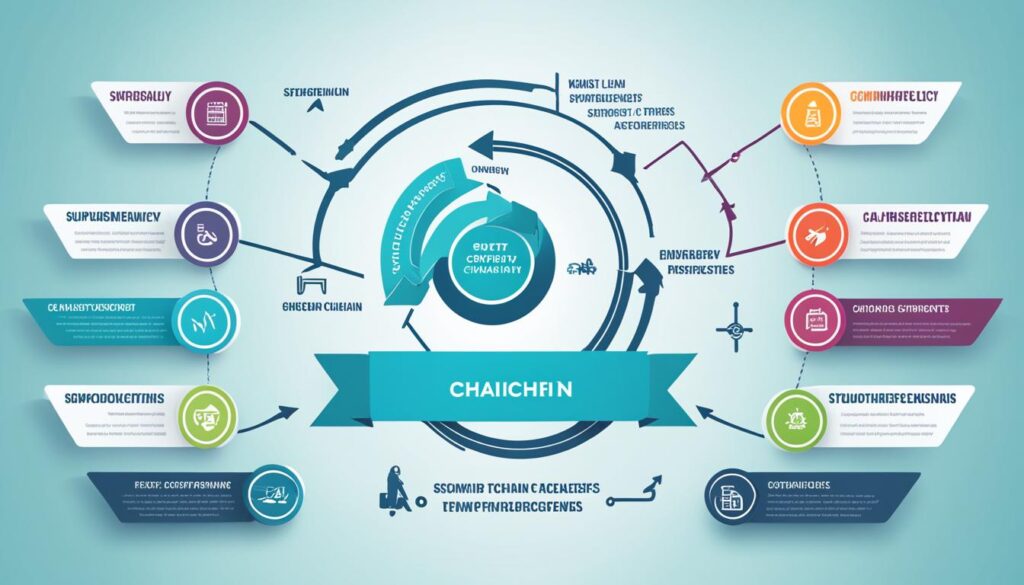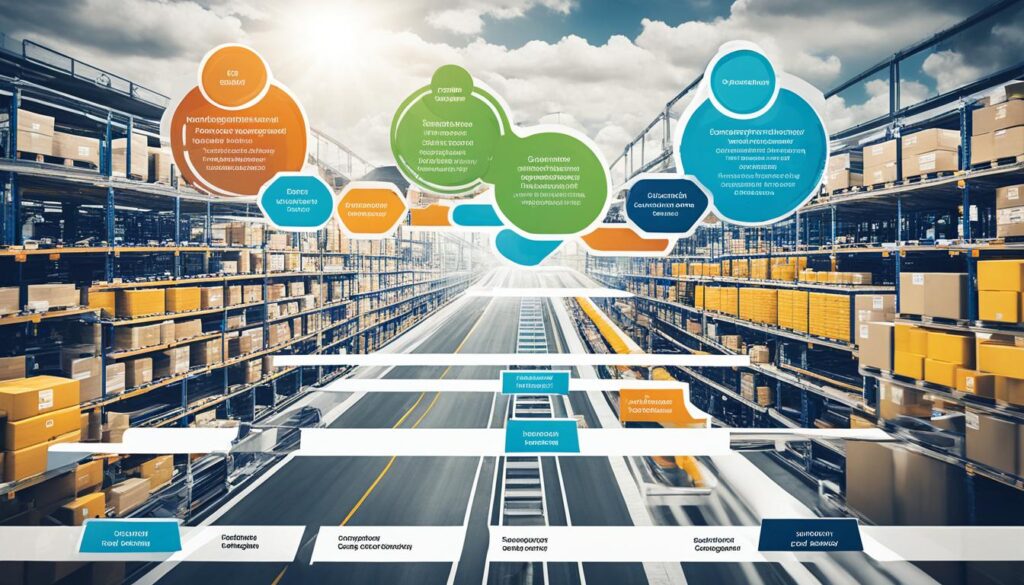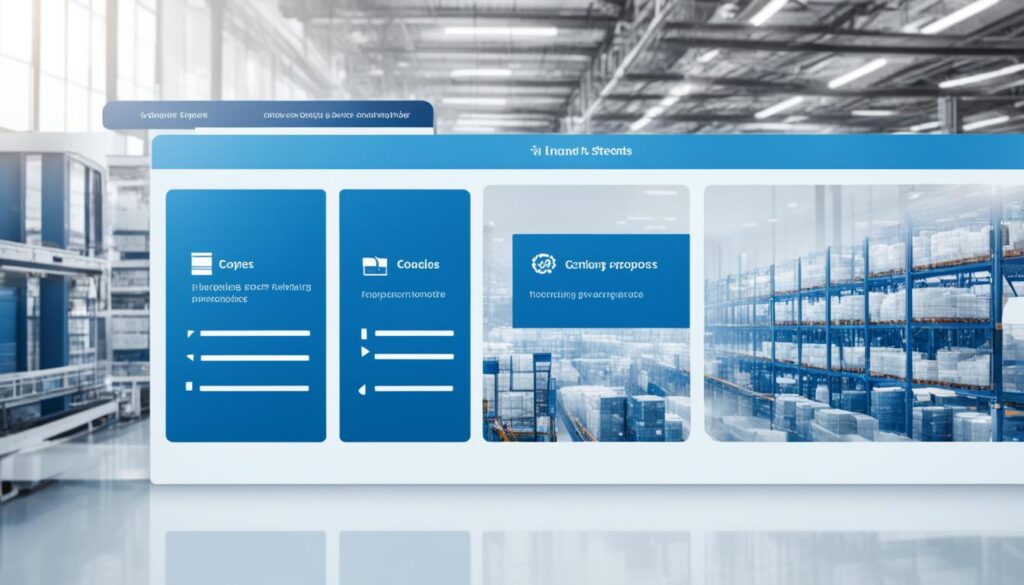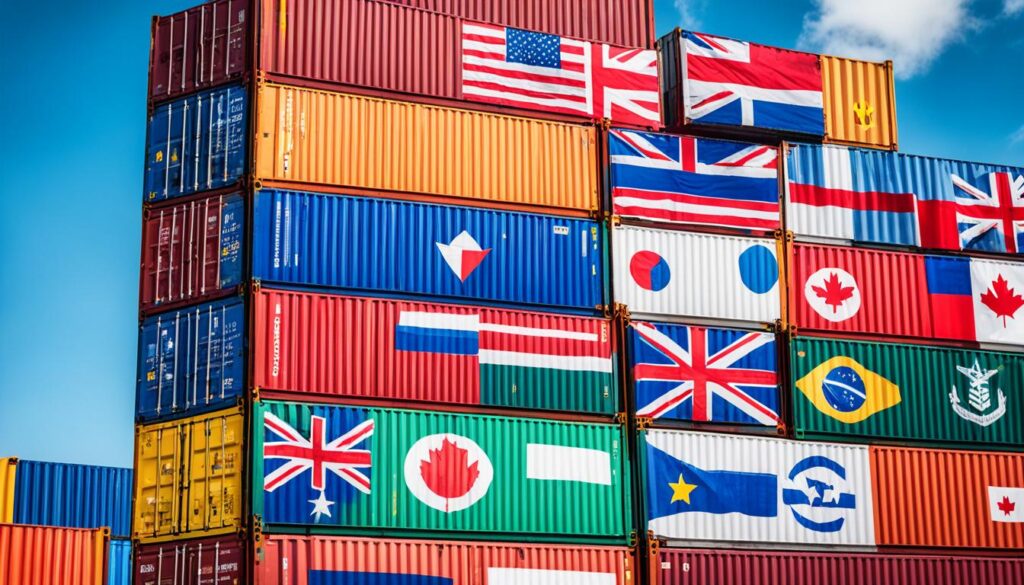How can businesses build a highly resilient supply chain management process that ensures success in today’s global marketplace?
Supply chain management plays a crucial role in the success of businesses, enabling the efficient flow of goods and services from suppliers to customers. However, according to recent studies, only 21% of supply chain leaders believe they have a highly resilient supply chain management process in place. This raises the question: what are the effective strategies that leading companies have implemented to build a resilient and robust supply chain?
In this article, we will explore the concept of supply chain strategy and delve into the best practices that successful companies have adopted. From optimizing logistics and procurement to efficient inventory management and fostering strong vendor relationships, we will uncover the key elements of effective supply chain management. Join me as we uncover the strategies that can drive supply chain optimization, improve warehousing and transportation, and enhance demand forecasting.
Key Takeaways:
- Building a resilient supply chain management process is crucial for business success in today’s global marketplace.
- Many supply chain leaders lack confidence in the resilience of their current supply chain management processes.
- Effective supply chain strategies encompass logistics, procurement, inventory management, vendor relationships, transportation, and demand forecasting.
- Leading companies have implemented various strategies to optimize their supply chains, enhance efficiency, and improve customer satisfaction.
- Exploring and implementing effective supply chain management strategies can give businesses a competitive edge and ensure long-term success.
What Is a Supply Chain Strategy?
A supply chain strategy is the long-term plan developed by a company to effectively manage its supply chain operations and achieve its business goals. It involves designing and coordinating the flow of goods and services from suppliers to customers, including procurement, production, transportation, and distribution. The goal is to create a streamlined and efficient supply chain that delivers high-quality products or services, meets customer demand, and maximizes profitability.
Having a well-defined supply chain strategy is essential for businesses to navigate the complexities of the global marketplace and stay ahead of the competition. It provides a roadmap for decision-making and serves as a guiding framework for supply chain managers to align their operations with the company’s overall objectives.
A supply chain strategy takes into account various factors, such as market demand, production capabilities, inventory management, and transportation logistics. It considers the company’s specific business goals and works towards achieving them through optimized supply chain processes and operations.
“A supply chain strategy is like a blueprint that ensures the efficient movement of goods and services from suppliers to end customers, enabling companies to meet customer demands, reduce costs, and increase profitability.”
By implementing a well-defined supply chain strategy, organizations can gain several advantages. They can achieve cost savings by optimizing procurement and production processes, reducing transportation and inventory costs, and improving overall supply chain efficiency. Additionally, a robust supply chain strategy facilitates better collaboration with suppliers and enhances the coordination of activities throughout the supply chain network.
Benefits of a Supply Chain Strategy:
- Effective management of supply chain operations
- Improved customer satisfaction through timely delivery and high-quality products or services
- Enhanced profitability through cost reduction and increased efficiency
- Streamlined procurement, production, transportation, and distribution processes
- Optimized inventory management to minimize carrying costs and stockouts
Implementing a well-designed supply chain strategy is crucial for organizations looking to remain competitive in today’s dynamic business environment. It provides a framework for aligning supply chain operations with business goals, optimizing processes, and delivering value to customers. By continuously evaluating and refining their supply chain strategies, companies can adapt to changing market conditions, drive innovation, and achieve long-term success.
Key Components of a Supply Chain Strategy
Effective supply chain strategies consist of three key components: strategy design, strategy planning, and strategy execution. These components are crucial for optimizing supply chain operations and achieving business goals. Let’s explore each component in detail.
1. Strategy Design
Strategy design is the initial phase of developing a supply chain strategy. It involves analyzing existing systems and processes, reviewing suppliers, and assessing warehouse locations and technology. During this phase, it is essential to identify areas of improvement and potential bottlenecks in the supply chain. By evaluating and optimizing these elements, companies can lay a strong foundation for a resilient and efficient supply chain.
2. Strategy Planning
Once the strategy design phase is complete, the next step is strategy planning. This phase involves mapping out the entire process of reaching the supply chain goals and objectives. It includes setting measurable targets, defining key performance indicators (KPIs), and outlining the necessary steps to achieve them. Strategy planning provides a structured framework that guides the implementation and management of the supply chain strategy.
3. Strategy Execution
The final component of a supply chain strategy is strategy execution. This phase translates the planned strategy into action. It involves involving key stakeholders, aligning the strategy with the overall business strategy, and tracking and monitoring performance. Effective communication and collaboration among all stakeholders are crucial during this stage to ensure smooth implementation and address any issues or challenges that may arise.
| Components of a Supply Chain Strategy | Key Activities |
|---|---|
| Strategy Design | – Analyzing existing systems and processes – Reviewing suppliers – Assessing warehouse locations and technology |
| Strategy Planning | – Setting measurable targets – Defining KPIs – Outlining steps to achieve goals |
| Strategy Execution | – Involving key stakeholders – Aligning strategy with overall business strategy – Tracking and monitoring performance |
Implementing an effective supply chain strategy requires careful consideration of these key components. By strategically designing, planning, and executing the supply chain strategy, organizations can optimize their operations, enhance supply chain performance, and achieve sustainable growth.

Types of Supply Chain Strategies
Organizations can adopt different types of supply chain strategies to optimize operations and improve efficiency. These strategies are designed to align with specific business objectives and customer needs. Let’s explore some of the key types of supply chain strategies:
Demand-Driven Strategy
A demand-driven strategy focuses on integrating demand signals throughout the supply chain to meet customer needs. By closely monitoring customer demand patterns and collaborating with suppliers, organizations can ensure that products are available when customers require them. This customer-centric approach allows companies to enhance customer satisfaction and increase overall efficiency.
Agile Strategy
An agile supply chain strategy prioritizes flexibility and responsiveness to changes in demand or market conditions. Organizations that adopt this strategy have the ability to quickly adjust their production and distribution processes to meet unforeseen changes. This agility allows them to effectively manage supply chain risks and capitalize on market opportunities, leading to improved efficiency and customer satisfaction.
Collaborative Strategy
A collaborative strategy involves working closely with suppliers, customers, and other partners to improve efficiency and customer satisfaction through sharing information and resources. By fostering strong relationships and open communication, organizations can streamline processes, reduce costs, and deliver products or services more effectively. Supplier collaboration, in particular, can lead to better coordination, reduced lead times, and overall supply chain optimization.
These different supply chain strategies offer organizations the flexibility to tailor their approach based on their unique business requirements. By selecting and implementing the most suitable strategy, companies can drive efficiency, reduce costs, and enhance customer satisfaction.

Unilever’s Collaborative Planning, Forecasting, and Replenishment (CPFR) Strategy
Unilever, a global consumer goods company, has successfully implemented a Collaborative Planning, Forecasting, and Replenishment (CPFR) strategy to drive operational efficiency and improve its supply chain performance. This innovative strategy focuses on enhancing forecast accuracy, reducing inventory holding, and increasing sales volume through close collaboration with select retail clients.
By leveraging supplier collaboration and embracing supply chain visibility, Unilever has achieved significant improvements in forecast accuracy, enabling better demand planning and inventory management. This has resulted in reduced stockouts and improved customer satisfaction. Additionally, by actively collaborating with its retail partners, Unilever has optimized asset utilization and streamlined the replenishment process, resulting in reduced inventory holding and improved efficiency.
Unilever’s CPFR strategy has not only strengthened its relationships with retail clients but also enhanced its overall supply chain performance. The company now has a more accurate understanding of customer demand, allowing it to optimize production and distribution processes accordingly. This has led to improved sales volume and increased customer loyalty.
The success of Unilever’s CPFR strategy highlights the importance of supplier collaboration, forecast accuracy, and supply chain visibility in driving operational excellence. By implementing these best practices, companies can achieve a competitive advantage, improve customer satisfaction, and drive profitable growth in today’s dynamic business environment.
Starbucks’ Vertically Integrated Supply Chain
Starbucks, a renowned coffee company, has established a vertically integrated supply chain to ensure the quality and ethical sourcing of its coffee beans. Through direct interaction with growers, Starbucks collaborates with them to enforce strict criteria for ethical and environmental standards. This commitment is exemplified through their involvement in the Coffee and Farmer Equity (C.A.F.E.) Practices program, which promotes fair trade coffee and sustainability.
To streamline their supply chain operations, Starbucks has implemented various supply chain structure and management tools. They have categorized activities, centralized logistics, and introduced a comprehensive scorecard system. These initiatives have transformed their complex supply chain into a simplified and cost-effective process. As a result, Starbucks has experienced improved efficiency, increased responsiveness, and higher sales revenue.
Embracing digital technologies further enhances their supply chain management. Starbucks utilizes various digital tools to facilitate communication, collaboration, and optimization of their operations. From inventory management systems to demand forecasting software, digital technologies play a crucial role in ensuring seamless coordination and efficient decision-making.
“Our vertically integrated supply chain allows us to have direct control over every step involved in bringing the finest coffee to our customers, from farm to cup. We are committed to not only delivering exceptional coffee but also to promoting responsible and sustainable practices throughout our supply chain.”
– Starbucks Executive
Ethical Sourcing and Direct Interaction
Starbucks’ vertically integrated supply chain gives them the ability to directly interact with growers, fostering strong relationships and ensuring transparency. This direct communication enables them to work collaboratively with growers to meet the highest standards of quality and sustainability.
The Coffee and Farmer Equity (C.A.F.E.) Practices Program
Starbucks’ commitment to ethical sourcing is evident through their active participation in the Coffee and Farmer Equity (C.A.F.E.) Practices program. This program ensures fair trade coffee practices and promotes environmental sustainability, supporting the well-being of coffee-growing communities worldwide.
Streamlined Supply Chain Structure and Management Tools
Starbucks’ supply chain structure is designed to streamline operations and enhance efficiency. By categorizing activities, centralizing logistics, and implementing a scorecard system, they have created a well-organized and cost-effective supply chain. These management tools enable Starbucks to track and monitor performance, identify areas for improvement, and optimize their supply chain processes.
Digital Technologies for Enhanced Supply Chain Management
Starbucks leverages digital technologies to further enhance their supply chain management capabilities. From inventory management systems and demand forecasting software to digital communication platforms, these technologies enable Starbucks to make data-driven decisions, improve efficiency, and respond quickly to market demands.

Walmart’s Strategic Vendor Relationships
At Walmart, we understand the importance of maintaining strategic vendor relationships to optimize our supply chain. Collaborating closely with our suppliers allows us to streamline operations, enhance efficiency, reduce costs, and ultimately improve customer satisfaction.
By forging strong partnerships with our vendors, we ensure a steady supply of products, eliminating any disruptions that may arise from unreliable suppliers. This enables us to consistently meet customer demands, making Walmart a trusted and reliable retailer.
In addition to a seamless supply chain, our strategic vendor relationships also help us reduce lead times, allowing us to efficiently replenish our inventory and stay ahead in a highly competitive market. By working collaboratively, we can swiftly respond to changes in customer preferences and market trends, ensuring that our shelves are always stocked with the products our customers desire.
One of the key elements of our supplier collaboration is the sharing of data and insights. By working closely with our vendors, we gather valuable information about consumer behavior, market demand, and emerging trends. This enables us to make data-driven decisions, optimize our product offerings, and stay ahead of the competition.
“Collaborating closely with our suppliers allows us to streamline operations, enhance efficiency, reduce costs, and ultimately improve customer satisfaction.”
At Walmart, efficiency is a critical factor in maintaining our competitive edge. Through strategic vendor relationships, we are able to streamline our supply chain, eliminating unnecessary steps and enhancing overall efficiency. This not only reduces costs but also allows us to allocate resources more effectively, resulting in a lean and agile supply chain.
Furthermore, our focus on strategic vendor relationships aligns with our commitment to cost reduction. By collaborating closely with our suppliers, we can negotiate favorable terms, optimize transportation and logistics, and identify innovative solutions to drive down costs at every stage of the supply chain.
Ultimately, our strategic vendor relationships play a crucial role in enhancing customer satisfaction. By working closely with suppliers who share our commitment to quality and reliability, we can ensure that our customers receive products of the highest standard. This results in a positive shopping experience and builds trust and loyalty among our valued customers.
“Through strategic vendor relationships, we are able to streamline our supply chain, eliminating unnecessary steps and enhancing overall efficiency.”
At Walmart, we recognize that our strategic vendor relationships are integral to our success. They allow us to create a streamlined and efficient supply chain, resulting in improved efficiency, cost reduction, and ultimately, enhanced customer satisfaction. By continuing to collaborate closely with our suppliers, we aim to drive further innovation and excellence in supply chain management.
The Importance of Supply Chain Optimization
In today’s competitive business landscape, supply chain optimization plays a crucial role in driving efficiency, reducing costs, and enhancing customer satisfaction. By implementing effective strategies and leveraging the power of technology and continuous improvement, organizations can unlock significant value and gain a competitive edge in the market.
The Benefits of Supply Chain Optimization
When supply chain optimization is prioritized, several benefits can be realized:
- Improved Efficiency: By analyzing data and identifying bottlenecks, organizations can streamline their supply chain processes, eliminating inefficiencies and reducing lead times. This leads to smoother operations, faster order fulfillment, and increased productivity.
- Cost Reduction: Supply chain optimization enables organizations to identify cost-saving opportunities, such as optimizing transportation routes, reducing inventory holding costs, and improving procurement processes. By implementing these changes, organizations can achieve significant cost reductions and improve their bottom line.
- Enhanced Customer Satisfaction: A well-optimized supply chain ensures that products or services are delivered to customers in a timely manner, meeting their expectations and enhancing their overall experience. This leads to increased customer satisfaction, loyalty, and retention.
Key Elements of Supply Chain Optimization
Supply chain optimization requires a holistic approach that encompasses various elements:
- Data Analysis: By leveraging advanced analytical tools, organizations can gain valuable insights from supply chain data, identify patterns, and make data-driven decisions. This allows them to optimize inventory levels, improve demand forecasting accuracy, and enhance overall supply chain performance.
- Process Improvement: Continuous process improvement is a key component of supply chain optimization. By employing methodologies like Lean or Six Sigma, organizations can eliminate waste, streamline processes, and increase operational efficiency.
- Technology: Embracing technology solutions such as advanced planning systems, supply chain visibility platforms, and automation tools can significantly improve supply chain optimization. These technologies enhance communication, automate manual tasks, and enable real-time monitoring, leading to better decision-making and proactive risk management.
- Continuous Improvement: Optimizing the supply chain is an ongoing endeavor. By continuously monitoring performance, benchmarking against industry standards, and seeking feedback from stakeholders, organizations can drive continuous improvement and stay ahead of the competition.
To illustrate the impact of supply chain optimization, consider the following table:
| Optimization Strategy | Result |
|---|---|
| Data-driven demand forecasting using advanced analytics | Improved forecast accuracy, reducing stockouts and overstocks |
| Streamlined transportation routes and logistics | Reduction in transportation costs and improved delivery times |
| Implementation of automation technologies | Increased operational efficiency and reduced manual errors |
| Collaboration with key suppliers | Improved supplier performance, better inventory management |

Effective supply chain optimization is an essential aspect of modern business success. It enables organizations to achieve greater efficiency, cost reduction, and customer satisfaction, ensuring they can meet market demands and drive growth in a rapidly evolving business environment.
Strengthening Supply Chain Resilience
In today’s fast-paced and unpredictable business landscape, it is essential for organizations to strengthen their supply chain resilience. Implementing effective strategies can help businesses navigate through unforeseen delays, mitigate the impact of disruptions, and improve overall risk management. Let’s explore some key strategies that can enhance supply chain resilience and ensure business continuity.
1. Placing Buffers Along the Supply Chain
A buffer is a strategic inventory or capacity set aside at various points along the supply chain to absorb any unexpected disruptions or delays. By having buffers in place, organizations can maintain smoother operations even when faced with supply chain challenges. This allows them to respond promptly to changes in demand or unexpected disruptions, reducing the potential impact on customer service and minimizing financial losses.
2. Diversification of Manufacturing and Sourcing Networks
Diversifying manufacturing and sourcing networks is an effective way to enhance supply chain resilience. By spreading production across multiple locations or suppliers, organizations can reduce their reliance on a single source and mitigate risks associated with potential disruptions. This strategy ensures a more robust supply chain that can withstand unforeseen events such as natural disasters, geopolitical uncertainties, or supplier issues.
3. Investing in Demand Forecasting
Accurate demand forecasting plays a critical role in supply chain resilience. By leveraging advanced data analytics and forecasting tools, organizations can gain insights into market trends, customer preferences, and demand fluctuations. This enables them to align their production, inventory, and distribution strategies accordingly, reducing the risk of stockouts or excess inventory. Effective demand forecasting helps organizations meet customer demand efficiently and maintain optimal inventory levels.
4. Standardization of Processes
Standardizing processes within the supply chain can improve efficiency, reduce errors, and enhance overall resilience. By establishing clear and consistent procedures for procurement, production, quality control, and logistics, organizations can streamline operations and minimize disruptions caused by inconsistent practices or variations in performance. Standardization also facilitates effective communication and collaboration among stakeholders, improving agility and response times.
By implementing these strategies, organizations can strengthen their supply chain resilience, enabling them to adapt to changing market conditions, minimize risks, and sustain long-term success. Building a resilient supply chain is a proactive approach that ensures businesses can effectively navigate challenges and capitalize on opportunities in an increasingly dynamic and competitive environment.

Supply Chain Management Lessons from the COVID-19 Pandemic
The COVID-19 pandemic has undoubtedly disrupted supply chains worldwide, causing unprecedented challenges for businesses. Supply chain leaders have quickly realized the importance of resilience and agility in navigating through these disruptions. The previously favored lean supply chain strategies have taken a backseat as organizations strive to build robust and adaptable supply chains that can withstand future uncertainties.
One key lesson learned from the pandemic is the need for enhanced supply chain visibility. The ability to track and monitor every step of the supply chain is crucial in identifying potential disruptions and implementing proactive measures. Supply chain leaders are now investing in advanced technologies such as blockchain and IoT to improve real-time visibility and enable effective decision-making.
Another important aspect that has emerged is the importance of contingency planning. The pandemic has highlighted the vulnerability of supply chains to unexpected events. Companies are now developing contingency plans to mitigate risks and ensure business continuity. This includes diversifying sourcing and manufacturing locations, building supplier relationships, and stockpiling critical inventory.
“The COVID-19 pandemic has been a wake-up call for businesses to reassess their supply chain strategies and strengthen their resilience. It has forced us to take a step back and reevaluate our approach to risk management and agility,” says John Thompson, a renowned supply chain expert.
Furthermore, the pandemic has underscored the importance of collaboration and communication among supply chain partners. Establishing strong relationships with suppliers, customers, and logistics providers has become imperative in navigating through disruptions. Supply chain leaders are prioritizing effective communication channels and sharing critical information to respond swiftly to changing market conditions.
As organizations continue to adapt to the post-pandemic landscape, supply chain agility is now a top priority. This involves building flexibility and responsiveness into supply chain processes to quickly adapt to market fluctuations and changing customer demands. The focus is shifting towards creating a dynamic and agile supply chain that can quickly recover from disruptions and seize new opportunities.
In summary, the COVID-19 pandemic has reshaped the supply chain landscape, emphasizing the need for resilience, visibility, and agility. Supply chain leaders are actively reevaluating their strategies, investing in technology, and fostering collaboration to build stronger and more adaptive supply chains. By incorporating the lessons learned from this global crisis, businesses can better prepare for future disruptions and ensure the continuity of their operations.
4 Supply Chain Strategies for 2021
In order to stay competitive and resilient in today’s dynamic business environment, organizations need to adopt effective supply chain strategies. Here are four key strategies that can help companies optimize their supply chain operations and drive success in 2021:
1. Placing Buffers Along the Supply Chain
Buffers play a crucial role in managing uncertainties and disruptions within the supply chain. By strategically placing buffers at critical points, such as inventory levels or production capacity, companies can ensure a smoother flow of materials and minimize the impact of unforeseen events. Buffers act as a safety net, allowing organizations to absorb shocks and maintain continuity in their operations. Implementing this strategy requires a deep understanding of the supply chain dynamics and careful analysis of potential risks and vulnerabilities.
2. Diversifying Manufacturing and Sourcing Networks
Diversification is key to mitigating risks and increasing resilience in supply chains. By diversifying their manufacturing and sourcing networks, organizations can reduce their dependency on a single supplier or location. This strategy helps to minimize the impact of disruptions such as natural disasters, geopolitical uncertainties, or regulatory changes. By exploring alternative sourcing options and establishing partnerships with reliable suppliers across different regions, companies can ensure a more robust and adaptable supply chain.
3. Investing in Demand Forecasting
Demand forecasting plays a vital role in optimizing inventory levels, production capacity, and customer satisfaction. By leveraging data analytics and advanced forecasting techniques, companies can predict future demand more accurately. This allows them to align their supply chain operations with anticipated demand patterns and avoid costly overstocks or stockouts. Accurate demand forecasting helps organizations optimize their resource allocation, improve lead times, and enhance overall supply chain efficiency.
4. Standardizing Processes for Increased Productivity
Standardization is essential for streamlining supply chain operations and enhancing productivity. By establishing standardized processes, procedures, and performance metrics, organizations can eliminate inefficiencies, reduce errors, and promote consistent quality across the supply chain. Standardization also facilitates knowledge sharing and cross-functional collaboration within the organization. Implementing digital tools, automation, and real-time monitoring can further optimize productivity and enable organizations to respond swiftly to changing market demands.
| Strategy | Key Benefits |
|---|---|
| Placing Buffers Along the Supply Chain | – Enhanced resilience against disruptions – Minimized operational risks – Continuity in supply chain operations |
| Diversifying Manufacturing and Sourcing Networks | – Reduced dependency on single suppliers or locations – Mitigated risks from geopolitical or regulatory changes – Improved supply chain agility |
| Investing in Demand Forecasting | – Optimized inventory levels and production capacity – Improved customer satisfaction – Efficient resource allocation |
| Standardizing Processes for Increased Productivity | – Streamlined operations and reduced inefficiencies – Consistent quality and performance – Facilitated cross-functional collaboration |
Benefits of a Resilient Supply Chain Strategy
An effective and resilient supply chain strategy provides numerous advantages to organizations, allowing them to thrive in today’s dynamic business environment. By implementing a resilient supply chain strategy, companies can experience improved productivity, reduced risk, and gain a competitive advantage in their respective industries.
A resilient supply chain enables organizations to adapt quickly to market changes. With the ability to anticipate and respond to shifts in customer demands and market trends, companies can make timely adjustments to their operations, ensuring their products or services remain relevant and in high demand. This adaptability also allows for increased output capacity, enabling organizations to meet customer needs more efficiently and effectively.
In addition, a resilient supply chain strategy helps organizations reduce risk. By implementing robust risk management practices and building resilience into their supply chains, companies can mitigate the impact of disruptions and minimize potential losses. These risk reduction measures may include diversifying suppliers and manufacturing networks, implementing contingency plans, and investing in technology to enhance supply chain visibility and communication.
Furthermore, a resilient supply chain strategy promotes innovation within an organization. By continuously evaluating and optimizing supply chain processes and technologies, companies can identify new opportunities for improvement and innovation. This focus on innovation allows organizations to stay ahead of their competitors by developing new products, services, or operational strategies that meet evolving customer needs and preferences.
In conclusion, a resilient supply chain strategy is not only crucial for business continuity but also offers significant advantages to organizations. Improved productivity, reduced risk, and innovation contribute to a competitive advantage that empowers companies to thrive in today’s fast-paced and unpredictable business landscape. By investing in a resilient supply chain strategy, businesses can position themselves for long-term success and profitability.






